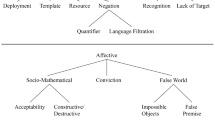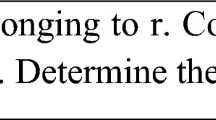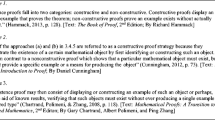Abstract
The formal acceptance of a mathematical proof is based on its logical correctness but, from a cognitive point of view, this form of acceptance is not always naturally associated with the feeling that the proof has necessarily proved the statement. This is the case, in particular, for proof by contradiction in geometry, which can be linked to a loss of evidence in various ways, owing to its particular logical structure and to the difficulty in managing geometrical figures with contradictory properties. In this paper, we observe that students produce argumentation by starting with the assumption that the claim is false (indirect argumentation), and that they seem to accept this as more evident than the proofs by contradiction. On the basis of the notion of intuitive knowledge developed by Fischbein and through the analysis of task-based interviews, we investigate the intuitive acceptance of proof by contradiction and of indirect argumentation, underlining, in particular, that indirect argumentation can be produced as a compromise between a proof by contradiction and the need for a more evident argument.








Similar content being viewed by others
References
Antonini, S. (2004). A statement, the contrapositive and the inverse: intuition and argumentation. In M. Johnsen Høines, & A. Berit Fuglestad (Eds.), Proceedings of the 28th Conference of the International Group for the Psychology of Mathematics Education (Vol. 2, pp. 47–54). Norway: Bergen.
Antonini, S., & Mariotti, M. A. (2008). Indirect proof: What is specific to this way of proving? ZDM Mathematics Education, 40(3), 401–412.
Antonini, S., & Mariotti, M. A. (2010). Abduction and the explanation of anomalies: The case of proof by contradiction. In V. Durand-Guerrier, S. Soury-Lavergne, & F. Arzarello (Eds.), Proceedings of the 6th Conference of European Research in Mathematics Education (pp. 322–331). France: Lyon.
Baccaglini-Frank, A. (2010). Conjecturing in dynamic geometry: A model for conjecture-generation through maintaining dragging. Doctoral dissertation, University of New Hampshire, Durham, NH. ProQuest.
Baccaglini-Frank, A., Antonini, S., Leung, A., & Mariotti, M. A. (2017). Designing non-constructability tasks in a dynamic geometry environment. In A. Leung & A. Baccaglini-Frank (Eds.), Digital technologies in designing mathematics education tasks—Potential and pitfalls (pp. 99–120). New York: Springer.
Baccaglini-Frank, A., Antonini, S., Leung, A. S., & Mariotti, M. A. (2018). From pseudo-objects in dynamic explorations to proof by contradiction. Digital Experiences in Mathematics Education, 4(2–3), 87–109.
Barbin, E. (1988). La démonstration mathématique: Significations épistémologiques et questions didactiques. Bulletin APMEP, 366, 591–620.
Boero, P. (Ed.). (2007). Theorems in school: From history, epistemology and cognition to classroom practice. Rotterdam: Sense Publishers.
Chazan, D. (1993). High school geometry students’ justification for their views of empirical evidence and mathematical proof. Educational Studies in Mathematics, 24(4), 359–387.
de Villiers, M. (1990). The role and function of proof in mathematics. Pythagoras, 24, 17–24.
Dummett, M. (1977). Elements of intuitionism. New York: Oxford University Press.
Duval, R. (1992–1993). Argumenter, demontrer, expliquer: coninuité ou rupture cognitive? Petit x, 31, 37–61.
Duval, R. (1995). Sémiosis et Pensée Humain. Bern: Peter Lang.
Duval, R. (1998). Geometry from a cognitive point of view. In C. Mammana & V. Villani (Eds.), Perspectives on the teaching and learning of Geometry for the 21st Century (pp. 37–52). Dordrecht: Kluwer.
Fischbein, E. (1982). Intuition and proof. For the Learning of mathematics, 3(2), 9–24.
Fischbein, E. (1987). Intuition in science and mathematics. Dordrecht: Kluwer.
Fischbein, E. (1993). The theory of figural concepts. Educational Studies in Mathematics, 24(2), 139–162.
Freudenthal, H. (1973). Mathematics as an educational task. Dordrecht: Reidel.
Giaquinto, M. (1992). Visualizing as a means of geometrical discovery. Mind and Language, 7, 381–401.
Hanna, G., & de Villiers, M. (Eds.). (2012). Proof and proving in mathematics education. The 19th ICMI study. Dordrecht: Springer.
Hanna, G., & Sidoli, N. (2007). Visualisation and proof: A brief survey of philosophical perspectives. ZDM Mathematics Education, 39, 73–78.
Harel, G. (2007). Students’ proof schemes revisited. In P. Boero (Ed.), Theorems in school: From history, epistemology and cognition to classroom practice (pp. 65–78). Rotterdam: Sense Publishers.
Laborde, C. (1998). Relationship between the spatial and the theoretical in geometry: The role of computer dynamic representations in problem solving. In D. Tinsley & D. Johnson (Eds.), Information and communication technologies in school mathematics (pp. 183–194). London: Chapman & Hall.
Leron, U. (1985). A direct approach to indirect proofs. Educational Studies in Mathematics, 16(3), 321–325.
Leung, A., & Lopez-Real, F. (2002). Theorem justification and acquisition in dynamic geometry: A case of proof by contradiction. International Journal of Computers for Mathematical Learning, 7(2), 145–165.
Lolli, G. (2005). A cosa servono le dimostrazioni nella scuola e nella ricerca. http://docplayer.it/70935634-A-cosa-servono-le-dimostrazioni-nella-scuola-e-nella-ricerca.html. Accessed 14 May 2018.
Magnani, L. (2001). Abduction, reason, and science. Processes of discovery and explanation. New York: Kluwer.
Mancosu, P. (1996). Philosophy of mathematical practice in the 17th century. New York: Oxford University Press.
Mariotti, M. A. (1995). Images and concepts in Geometrical reasoning. In R. Sutherland & J. Mason (Eds.), Exploiting mental imagery with computer in mathematics education (pp. 97–116). Berlin: Springer.
Mariotti, M. A. (2006). Proof and proving in mathematics education. In A. Gutierrez & P. Boero (Eds.), Handbook of research on the psychology of mathematics education: Past, present and future (pp. 173–204). Rotterdam: Sense Publishers.
Mariotti, M. A., & Antonini, S. (2009). Breakdown and reconstruction of figural concepts in proofs by contradiction in geometry. In F. L. Lin, F. J. Hsieh, G. Hanna, & M. de Villiers (Eds.), Proof and proving in mathematics education, ICMI Study 19 Conference Proceedings (vol. 2, pp. 82–87). Taiwan: Taipei.
Mariotti, M. A., Bartolini Bussi, M., Boero, P., Ferri, F., & Garuti, R. (1997). Approaching geometry theorems in contexts: From history and epistemology to cognition. In E. Pehkonen (Ed.), Proceedings of the 21th Conference of the International Group for the Psychology of Mathematics Education (Vol. 1, pp. 180–195). Finland: Lahti.
Mariotti, M. A., & Fischbein, E. (1997). Defining in classroom activities. Educational Studies in Mathematics, 34, 219–224.
Murray, J. A. H., et al. (Eds.). (1961). The Oxford English Dictionary: Being a corrected re-issue with an introduction, supplement, and bibliography of A New English Dictionary on Historical Principles 3: D-E. The Philological Society. Oxford: The Clarendon Press.
Partridge, E. (1958). Origins: A short etymological dictionary of modern English. London: Routledge & Kegan-Paul.
Reid, D., & Dobbin, J. (1998). Why is proof by contradiction difficult? In A. Olivier & K. Newstead (Eds.), Proceedings of the 22th Conference of the International Group for the Psychology of Mathematics Education (Vol. 4, pp. 41–48). Stellenbosch, South Africa.
Stylianides, A., Bieda, K., & Morselli, F. (2016). Proof and argumentation in mathematics education research. In A. Gutiérrez, G. Leder, & P. Boero (Eds.), 2nd handbook on the psychology of mathematics education (pp. 315–351). Rotterdam: Sense Publishers.
Szabó, A. (1978). The beginnings of Greek mathematics. Dordrecht: Reidel.
Thompson, D. R. (1996). Learning and teaching indirect proof. The Mathematics Teacher, 89(6), 474–482.
Wu Yu, J.-Y., Lin, F.-L., & Lee, Y.-S. (2003). Students’ understanding of proof by contradiction. In N. Pateman, B. Dougherty, & J. Zilliox (Eds.), Proceedings of the 2003 Joint Meeting of PME and PME-NA (Vol. 4, pp. 443–449). Hawaii: Honolulu.
Acknowledgements
I wish to thank Anna Baccaglini-Frank and Maria Alessandra Mariotti for many interesting and helpful discussions. The exchanges with them have led to many ideas in this paper.
Author information
Authors and Affiliations
Corresponding author
Additional information
Publisher's Note
Springer Nature remains neutral with regard to jurisdictional claims in published maps and institutional affiliations.
Rights and permissions
About this article
Cite this article
Antonini, S. Intuitive acceptance of proof by contradiction. ZDM Mathematics Education 51, 793–806 (2019). https://doi.org/10.1007/s11858-019-01066-4
Accepted:
Published:
Issue Date:
DOI: https://doi.org/10.1007/s11858-019-01066-4




